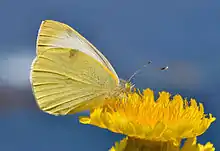Canary Islands large white
The Canary Islands large white (Pieris cheiranthi) is a species of butterfly in the family Pieridae. It is endemic to the Canary Islands (Spain).[1]
.jpg.webp)
| Canary Islands large white | |
|---|---|
 | |
| Scientific classification | |
| Kingdom: | Animalia |
| Phylum: | Arthropoda |
| Class: | Insecta |
| Order: | Lepidoptera |
| Family: | Pieridae |
| Genus: | Pieris |
| Species: | P. cheiranthi |
| Binomial name | |
| Pieris cheiranthi (Hübner, 1808) | |
.
Description
Very similar to Pieris brassicae, but the black discal patches are much larger and fused together. It reaches a size of 57 to 66 millimeters.
Distribution
The Canary white is widespread on La Palma , in Tenerife it is limited to the northern coastal areas. The last records from La Gomera dates back to 1975 and the species is probably extinct on that island. There are also unconfirmed reports from Gran Canaria.
Subspecies
- Pieris cheiranthi cheiranthi (Hübner, 1808)
- Pieris cheiranthi benchoavensis Pinker, 1969, La Palma (Canary Islands)
Habitat
The Canary White inhabits wet and moist shady gorges in laurel forests . It also occurs outside the laurel forest zone, for example, wet cliffs with a corresponding microclimate.
Biology
The female lays the eggs on the underside of leaves in piles of 5 to 50 . The larvae have a light green base color and are dotted black. At the top and sides they show a light yellow stripe. Among the food plants of the caterpillars are include Canary silverwort (Lobularia canariensis) and nasturtium ( Tropaeolum majus ). Crambe strigosa, endemic to the Canary Islands, seems to be the only natural food plant. The species flies in seven to eight consecutive generations, which partially overlap. The imago occurs throughout the year, a diapause is not known.
Threats
Threatened by habitat loss.
References
- van Swaay, C.; Wynhoff, I.; Verovnik, R.; Wiemers, M.; López Munguira, M.; Maes, D.; Sasic, M.; Verstrael, T.; Warren, M. & Settele, J. (2010). "Pieris cheiranthi". IUCN Red List of Threatened Species. 2010: e.T39484A10227844. doi:10.2305/IUCN.UK.2010-1.RLTS.T39484A10227844.en.
- M. Wiemers, 1995 The butterflies of the Canary Islands. A survey of their distribution, biology and ecology (Lepidoptera: Papilionoidea and Hesperioidea). First part. Linneana Belgica 1995 15:63-86
External links
 Data related to Pieris cheiranthi at Wikispecies
Data related to Pieris cheiranthi at Wikispecies Media related to Pieris cheiranthi at Wikimedia Commons
Media related to Pieris cheiranthi at Wikimedia Commons
